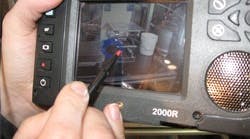James Boesken is manufacturing applied information technology engineer with the Corporate Engineering Group at Procter & Gamble (P&G, www.pg.com) in Cincinnati, where the company is headquartered. He analyzes and purchases systems that can be used across all product lines. For much of the past 10 years, he has focused on the use of video technology as it applies to the factory floor.
In 2007, Boesken was contacted by Chuck Yeazell, a fellow P&G engineer, who was looking for a video system to reduce travel of his engineering group. Developed by Librestream Technologies (www.librestream.com), Onsight consists of handheld devices slightly larger than a 35 mm camera and accompanying software. The system brings traditional videoconferencing to the manufacturing plant.
Boesken and Yeazell saw the potential value of Onsight. P&G, a consumer packaged goods manufacturer with approximately 127,000 employees in more than 80 countries, has thousands of experts who specialize in every step of the manufacturing process. From production-line-equipment experts to package-design engineers, these individuals can be internal or external to the organization and are usually located in places other than the manufacturing facilities. Within P&G, each expert typically is based out of the regional Engineering Technical Center located on each continent. “P&G manufacturing is a 24/7 operation,” says Boesken. “Somewhere in the world, there’s a challenge at any given time.”
This was precisely the case for Yeazell’s group, a small core of engineers managing suppliers that specialize in plastic injection molds for various products. They found themselves spending half of their time flying all over the world to perform assessment and qualification work. Not only was this kind of travel physically taxing on the engineers, it also was costly in terms of airfare and productive time.
P&G engineers are able to telestrate, or draw on-screen, to share information remotely or identify problem areas via a live video feed.
Before purchasing new production line equipment, manufacturers often conduct a vendor-acceptance-test (VAT) stage at the vendor's location. This equipment is expensive, large and heavy so they have to be sure that it meets their specifications prior to accepting the shipment of the new equipment to their facilities. The VAT requires a cross-section of specialized skills from the interested company’s team to properly execute and interpret the test results. Manufacturers traditionally had to send an entire team of specialized engineers to the vendor’s location. Not only is this kind of travel physically taxing on the engineers, it is also costly in terms of airfare and productive time. For example, 50,000 Euros – about $68,000 – was saved when a Beijing Technical Center sent one engineer, instead of six, to test a bottle-filling machine in Italy.
When Boesken originally looked at the mobile collaboration technology, ROI was a key factor, along with simplicity of installation, ease of use and video quality. The quality of Onsight’s video, specifically its macro optics and ability to telestrate, or draw on-screen, would allow P&G’s engineers to see minute defects in equipment parts or tiny blemishes in products, he thought. Today, P&G organizations use Onsight in the maintenance and repair of existing equipment or in the assembly and inspection of new equipment.
“Onsight was much simpler to install and use from the end user’s standpoint than any other system we’d ever examined,” says Boesken. “Very quickly, they are deep in a conversation with the remote person and talking about the technical issue, and the video technology kind of drifts away. That’s really what the goal is — to not let the technology get in the way. It’s a tool to get the job done. We find that it only takes one instance and the investment pays out.”
Several years ago, P&G’s Injection Mold Capability Group in Cincinnati began a trial using six Onsight mobile devices and 10 Onsight Expert desktop applications. If a supplier had a problem, a mobile device was either shipped overnight to the plant for troubleshooting the next day or one engineer with the device would travel to the plant, rather than sending two or three. The devices were left permanently at the plants, and, within two months, a number of other manufacturing areas purchased their own systems for plant equipment use. Now Onsight systems are deployed worldwide across the majority of the company’s facilities, as well as supplier and OEM vendors.
